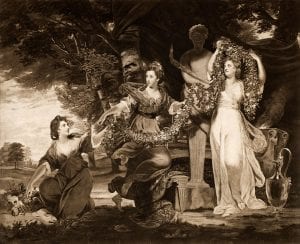Life imitates art: The Three Graces (1776)
From painting, to print, to pic

The Three Graces, housed in the Print Collection, is a 1776 print by Thomas Watson (1750-1781) after a 1773 painting by Sir Joshua Reynolds (1723-1792). The large print was created using the mezzotint method. Mezzotint involves scraping and polishing the surface of a copper or steel plate engraving to create different tones with both soft shades and rich blacks. This technique was used often in the 17th, 18th and 19th centuries for the reproduction of paintings, particularly portraits. The original painting was titled Three Ladies Adorning a Term of Hymen and it was commissioned by the politician Luke Gardiner, who was engaged to Elizabeth Montgomery, one of the three women depicted. Currently, it is part of the Tate collection.
Joshua Reynolds, a British portrait artist for the aristocracy, was known for developing the ‘Grand Manner’ style, which had the goal of making portraiture equivalent to the status of high art [1]. The old master painters influenced him, and the poses of the Montgomery sisters depicted in the picture mimic their works [2]. The sisters—Barbara, Elizabeth and Anne—are connected by a chain of flowers, paying tribute to the Greek God of Marriage, Hymen, whose statue stands behind them. One could interpret that the sisters represent fertility, of which flowers are a common motif. The Montgomery sisters are holding blooming flowers up to the God of Marriage, possibly celebrating their youth and preparation for motherhood. This is supported by Jonathan Jones, who writes that in the 18th century, the wealthy celebrated their class by painting themselves together, in order to pay tribute to the group rather than the individual [3]. He suggests the sisters’ portrayal shows their preparation for their “role as mothers of a new upper crust generation” [4].
The term ‘Grace’ comes from Greek mythology, and denotes one of three (or more) lesser goddesses, known together as the Graces. Each Grace is associated with a particular quality. The number and names of the Graces varies in mythology, however they are generally identified as being three: Aglaea, Euphrosyne, and Thalia, representing elegance, mirth, and youth/beauty respectively. The Graces were thought to be the daughters of Zeus and Eurynome. The Montgomery sisters were nicknamed the Irish Graces because they spent their childhood in Ireland.
The print owned by the University of Melbourne was purchased in 1993. Below is a light-hearted recreation of the print, featuring staff and interns from the Special Collections at the Baillieu Library. In the background is the statue unofficially titled Charity Being Kind to the Poor, designed by Victor Tilgner and sculpted by Edward W. Raht in 1893. The sculpture was gifted to the University of Melbourne in 1959.
Anastasia Vassiliadis, Special Collections and Grainger Museum Blogger
Citations
[1.] Tate, Three Ladies Adorning a Term of Hymen
[2.] Tate
[3.] Jonathan Jones, Three Ladies Adorning a Term of Hymen, Joshua Reynolds (1773)
[4.] Jonathan Jones
References
Encyclopaedia Britannica, Grace
Jonathan Jones, Three Ladies Adorning a Term of Hymen, Joshua Reynolds (1773)
Tate, Mezzotint
Tate, Three Ladies Adorning a Term of Hymen
The University of Melbourne, Sculpture on Campus
Victoria and Albert Museum, The Three Graces
Categories
- Uncategorised
- Joshua Reynolds
- Montgomery sisters
- Prints
- Three Graces

Leave a Reply